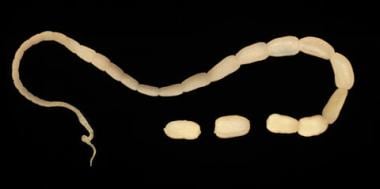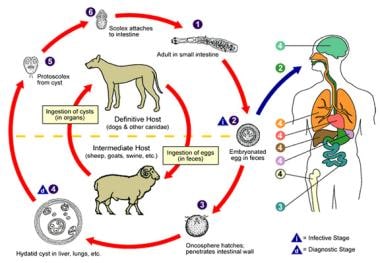Background
Tapeworms are long, segmented worms of the class Cestoda, which comprise 1 of 3 classes of parasitic worms (worms that require a host within which to mature). The other classes are Nematoda and Trematoda. These worms lack an intestinal tract and instead can absorb nutrients through their integument.
The adult consists of a head (scolex), where the worms attach to the mucosa of the intestine; a neck; and a segmented body that contains both male gonads and female gonads (proglottids).
 Adult tapeworm of Dipylidium caninum. Image courtesy of the Centers for Disease Control and Prevention (CDC).
Adult tapeworm of Dipylidium caninum. Image courtesy of the Centers for Disease Control and Prevention (CDC).
Cestodes include the following:
-
Taenia solium
-
Taenia saginata
-
Taenia asiatica [1]
-
Diphyllobothrium
-
Hymenolepis
-
Dipylidium caninum
-
Echinococcus
-
Spirometra
-
Taenia multiceps
Pathophysiology
Typically, a cestode requires one or more intermediate hosts in their life cycle. The life cycle is as follows:
-
The eggs are passed into the environment from the primary host.
-
The eggs are ingested by an intermediate host in which they hatch.
-
The larvae enter the tissues of the intermediate host and encyst.
-
The primary host ingests the cysts in the flesh of the intermediate host.
When humans are the primary hosts, the adult cestode is limited to the intestinal tract. When humans are the intermediate hosts, the larvae are within the tissues, migrating through the different organ systems.
In most cestode infestations (ie, T solium, T saginata, Diphyllobothrium species, Hymenolepis species, and D caninum), humans are the primary hosts. Adult worms survive inside their human hosts, where they are limited to the intestinal tract. Human fecal contamination of the environment is needed to sustain these life cycles.
In the remaining cestodes (ie, Echinococcus species, Spirometra species, and T multiceps), humans function as the intermediate hosts. Larvae exist within the tissues and migrate through different organ systems.
Hymenolepis species and T solium are the only cestodes for which humans can function as both primary hosts and intermediate hosts. Hymenolepis diminuta is primarily a cestode of rodents, although humans can be a rare and accidental hosts in the life cycle. Humans are infected by swallowing insects that contain cysticercoid larvae, most often by ingesting mealworms or grain beetles that infest dried grains, cereals, flour, and dried fruit.
Table 1. Cestodes and Their Hosts (Open Table in a new window)
Cestode |
Primary Host |
Intermediate Host |
T solium |
Humans |
Pigs, humans, dogs, cats, sheep |
T saginata |
Humans |
Cattle |
Diphyllobothrium |
Humans |
Fish |
Hymenolepis |
Humans |
Hymenolepis nana: None; Hymenolepis diminuta: Rodents |
D caninum |
Humans, dogs, cats |
Fleas on dogs/cats |
Echinococcus |
Dogs |
Humans, sheep, cattle, goats, horses, camel |
Spirometra |
Humans |
|
T multiceps |
|
Hares, rabbits, squirrels, humans (rarely) |
Epidemiology
Frequency
United States
Although many cestode infestations occur worldwide, only a few are common in the United States.
Diphyllobothriasis is an infection that occurs from eating raw or undercooked fish infected with Diphyllobothrium species. Diphyllobothrium organisms are present in lakes, rivers, and deltas of freshwaters. Eskimos in western Alaska and the West Coast of the United States are frequent hosts.
Echinococcus multilocularis causes alveolar echinococcosis, which occurs only in the northern hemisphere. In the United States, it occurs particularly in Alaska. Echinococcus granulosis causes hydatid disease, which occurs worldwide.
Although infection with T saginata (obtained from raw or undercooked beef) occurs worldwide, the prevalence in the United States is less than 1% because most cattle in the United States are free of the parasite. Infection with T solium is rare, but with the growing number of immigrants from endemic areas, the frequency is changing.
Infection with H nana is the most frequently diagnosed cestode infection in the United States.
Spirometra species cause sparganosis, which occurs accidentally in humans who ingest water containing infected cyclops, eating raw or inadequately cooked flesh of snakes, frogs, or birds. It has been reported mainly in the southeastern region of the United States.
International
T saginata has a high endemicity in Latin America, Africa, Middle East, and central Asia and has a moderate endemicity in Europe, south Asia, Japan, and the Philippines. [2]
T solium is prevalent in Latin America, the Slavic countries, Africa, southeast Asia, India, and China. The prevalence of T solium infection is low in northwestern Europe and is rare or absent in Canada. Cysticercosis, caused by infection with the larvae stage of the tapeworm, is endemic in all Latin American countries (except Chile, Argentina, and Uruguay).
Diphyllobothrium infection is prevalent in northern Europe (Finland, east Prussia, Russian Karelia), Canada, Africa, Japan, Taiwan, Manchuria, Siberia, Papua New Guinea, Australia, and South America.
H nana infection is the most common cestode of humans. It is prevalent in areas of poor hygiene and sanitation, especially in the warm and arid countries of the Mediterranean, Indian subcontinent, and South America. The prevalence in children in these areas may reach 20%. Infection rates are highest among children.
E multilocularis infection occurs only in the northern hemisphere, especially in central Europe, Russia, China, Japan, Canada, and north Africa. Few regions in the world are completely free from E granulosis.Echinococcus vogeli and Echinococcus oligarthrus infections occur in Central America and South America.
Infection with Spirometra species has been reported worldwide but especially in east Asia (China, Japan, and Korea) and southeast Asia (Malaysia, India, and the Philippines).
Mortality/Morbidity
Many cestode infestations are asymptomatic. However, once symptoms occur, they are usually vague GI complaints such as abdominal pain, anorexia, weight loss, or malaise.
Some of the more serious infestations result in symptoms from mass effects on vital organs, inflammatory responses, nutritional deficiencies, and the potential of fatal anaphylaxis.
Cysticercosis is a clinical syndrome of expanding embryonal cysts that occurs with T solium. The cysticerci that develop with T solium infestations can be found anywhere in the body, but they mainly occur in the central nervous system (neurocysticercosis) and skeletal muscles, causing local inflammatory responses and mass effects from the cystic growth. Cysticercosis is a common parasitic disease of the CNS. One of the most common manifestations is seizure. [3, 4] In endemic areas, it is a major cause of epilepsy. Neurocysticercosis may be the cause of death in many of these affected areas and may leave infected persons with irreversible brain damage.
The first study to systematically collect data on the frequency of neurocysticercosis worldwide found that one third of patients with epilepsy living in endemic communities showed neurocysticercosis brain lesions. [5]
Diphyllobothrium species absorb a large amount of vitamin B-12 and interfere with vitamin B-12 absorption from the ileum, resulting in vitamin B-12 deficiency (this can also occur with Taenia species). Severity depends on the proximity of the worm to the ileum, where vitamin B-12 is mainly absorbed in humans. Clinically, it resembles pernicious anemia (ie, hyperchromic, macrocytic, megaloblastic anemia) that responds well to vitamin supplementation therapy without long-term sequelae.
In Echinococcus infestations, humans ingest the eggs and the embryos escape, penetrate intestinal mucosa, and enter the portal circulation to invade other organs, mainly the liver (60%) and lungs (25%). The patient remains asymptomatic until the cysts cause a mass effect on the organ, which can be 5-20 years after the initial infestation.
Rupture or leakage of an Echinococcus cyst produces symptoms of fever, pruritus, urticaria, eosinophilia, and potentially fatal anaphylaxis.
Pulmonary hydatid cysts may rupture into the bronchial tree produce cough, dyspnea, chest pain, or hemoptysis. Pulmonary cysts rupture into the pleural space can result in abscess formation and pneumothorax, with or without pleural effusion. In addition, fever and acute hypersensitivity reactions ranging from wheezing to anaphylaxis can occur following cyst rupture.
If alveolar hydatid disease is left untreated, more than 90% of patients will die within 10 years from the onset of symptoms and almost 100% by 15 years.
Race
No racial risks or protections regarding cestode infestations are known.
Sex
Gender differences neither protect nor increase the risk of cestode infections.
Age
Many cestode infections are common in children as a result of their youthful habits and relatively less adequate hygiene. For instance, D caninum, one of the most common parasites of domestic dogs and cats, is typically obtained from fleas that live in the fur of these animals. Although infection of D caninum is rare, children, especially those who enjoy handling animals, are affected more frequently than adults.
-
Adult tapeworm of Dipylidium caninum. Image courtesy of the Centers for Disease Control and Prevention (CDC).
-
Ultrasonographic appearance of echinococcal cysts (Gharbi type I, World Health Organization [WHO] standardized classification CE1).
-
Diagram of the Echinococcus life cycle. Image courtesy of the Centers for Disease Control and Prevention.








